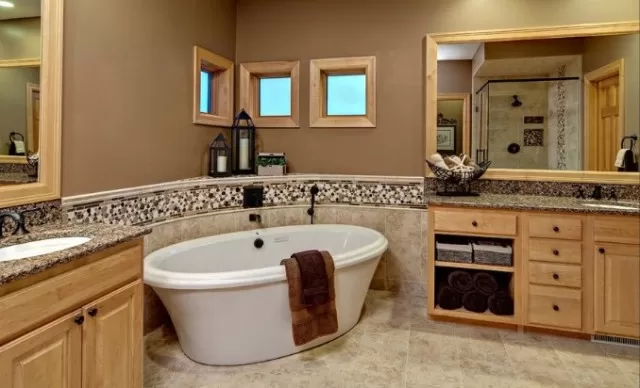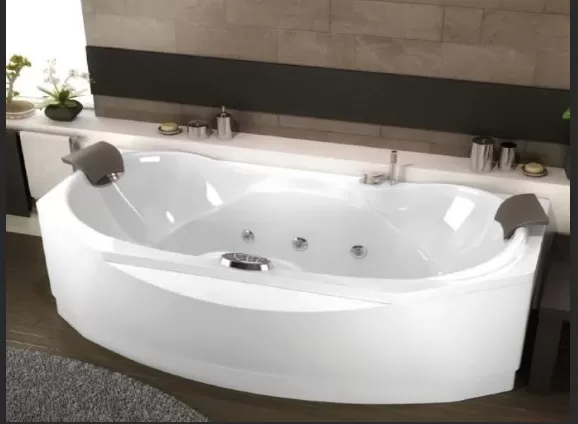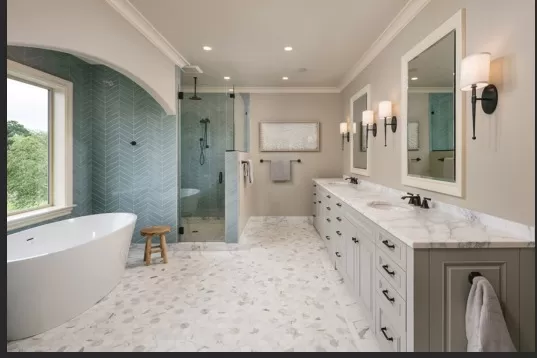The Bathtub Dilemma: Necessity in Every Home?. Ultimately, the decision to include a bathtub in your home depends on your lifestyle, preferences, available space, and specific needs. Consider your bathing habits, the potential benefits of a bathtub, and how it aligns with your long-term plans for the property. If space permits and you anticipate enjoying the relaxation and versatility it offers, a bathtub can be a worthwhile addition to your home.
Rethinking Bathtub Placement: Breaking the Tradition of Primary Suite Exclusive

Traditionally, it has been believed that the primary suite must feature a bathtub in the attached bathroom.
However, contemporary homes have been challenging this conventional notion. The emerging trend is to deviate from the norm and explore alternative arrangements.
While having at least one bathtub on the same floor as the homeowner’s bedroom is still advantageous, it doesn’t necessarily have to be located within the primary suite itself. Instead, it can be strategically positioned in a guest bathroom down the hall.
In lieu of a bathtub, the primary suite can be enhanced with innovative shower options that prioritize the specific needs and preferences of the homeowner.
For instance, a vertical shower spa with built-in seating can provide a luxurious and rejuvenating experience. Alternatively, there are numerous shower designs available that can be customized to cater to the homeowner’s unique requirements.
By reconsidering the traditional placement of bathtubs, homeowners have the opportunity to optimize their living spaces and explore new possibilities for their primary suites.
The focus shifts towards creating a personal oasis that aligns perfectly with individual preferences, ultimately redefining the concept of a truly luxurious and functional primary suite.
The Efficiency Advantage of Showers: Time and Water Savings
When it comes to efficiency, showers clearly take the lead.
From both a time and water conservation standpoint, showers offer distinct advantages over baths. In the United States, the average shower duration is around 8 minutes, consuming approximately 16 gallons of water. On the other hand, baths tend to be more leisurely and can last for over half an hour, utilizing approximately 70 gallons of water. It’s worth noting that this water consumption doesn’t even account for the additional water required to rinse off after a bath.
Considering these statistics, showers emerge as the more economical choice, potentially resulting in savings on water bills.
With their shorter duration and lower water usage, showers are a practical option for those concerned with both their environmental footprint and their finances. By opting for showers instead of baths, individuals can make a conscious effort to conserve water and reduce their overall consumption.
In addition to the efficiency aspect, showers also offer the convenience of quick cleansing, making them a preferred choice for busy individuals who value their time.
With their ability to provide an invigorating and refreshing experience within a relatively short period, showers allow for a seamless integration into daily routines without compromising on cleanliness and hygiene.
Overall, showers stand out as a more efficient and sustainable bathing option.
Their shorter duration, reduced water consumption, and time-saving attributes make them an attractive choice for those seeking to conserve resources while enjoying an effective and convenient bathing experience.
The Bathtub Conundrum: Considering Buyer Preferences

While some individuals prefer showers and may even remove a bathtub from their primary suite in favor of a spacious walk-in shower, it’s important to acknowledge that not having a bathtub can potentially be a deal-breaker for certain homebuyers.
If homeowners have long-term plans to stay in their current residence, the absence of a bathtub may not be a significant concern. However, if their intention is to sell the house in the near future and the floor plan does not include a tub, they might inadvertently limit their potential buyer pool.
Drawing from extensive experience in sales and house renovations, experts in the field, such as Moussa, have encountered buyers who outright refuse to purchase a house without a bathtub.
On the other hand, the presence of a bathtub in a home is unlikely to negatively impact a real estate transaction. Thus, considering the buyer’s perspective, it would be prudent to lean towards including at least one bathtub in the house, as it could make a difference in the ability to sell the property.
While the preference for showers may be more common among some individuals, it’s crucial to recognize the diverse preferences and needs of potential buyers.
By providing the option of a bathtub, homeowners can cater to a wider range of tastes and ensure that their home appeals to a larger buyer demographic. This consideration becomes particularly significant when selling a property, as maximizing its market appeal and accommodating the preferences of prospective buyers can enhance the chances of a successful sale.
Ultimately, the decision to include or exclude a bathtub in a home should be weighed against the homeowner’s long-term plans and the potential impact on the property’s marketability.
Striking a balance between personal preferences and the desires of potential buyers can play a pivotal role in the successful sale of a home.
The Hygiene Concern: Potential Bacterial Contamination in Jetted Tubs
It is important to note that jetted tubs, if not properly maintained, can become breeding grounds for bacteria, as emphasized by Moussa.
The internal pipes of jetted tubs, especially those lacking appropriate filtration or regular cleaning with suitable chemicals, have the potential to harbor bacteria and foster microbial growth. When the jets are activated, the forceful release of water can propel this bacteria into the tub, posing health risks to individuals using the tub.
The presence of bacteria in jetted tubs can lead to various health conditions.
For instance, exposure to contaminated water can increase the likelihood of developing urinary tract infections. Additionally, contact with the bacteria-infested water may result in skin irritations or infections, causing discomfort and potential medical complications.
To mitigate these risks, it is crucial to establish a stringent cleaning and maintenance routine for jetted tubs.
Regularly cleaning the internal pipes and implementing effective filtration systems can significantly reduce the accumulation of bacteria and microbial growth. Moreover, the use of appropriate sanitizing chemicals specifically designed for jetted tubs can help disinfect and ensure a hygienic bathing experience.
Awareness of the potential bacterial contamination in jetted tubs underscores the importance of diligent maintenance and cleaning practices.
By adopting proper care protocols, homeowners can minimize the risk of bacterial growth, safeguarding the health and well-being of individuals who utilize these tubs for relaxation and rejuvenation.
The Practical Appeal: The Necessity of a Bathtub for Specific Buyers

For certain individuals, having a bathtub is not just a matter of preference but a practical necessity.
While some enjoy the relaxation and therapeutic benefits of a bath, there are specific groups of people who rely on bathtubs for more essential reasons. Among these are families with young children or pets, for whom a bathtub becomes an indispensable feature in their homes.
In the case of families with young children, a bathtub is often a must-have.
While washing infants in the kitchen sink may suffice during their early stages, as they grow, the need for a proper tub becomes inevitable. Bathing children in a bathtub provides a safe and comfortable environment, allowing parents to easily clean and care for their little ones.
The spaciousness and convenience of a bathtub make it an ideal choice for ensuring proper hygiene and comfort during bath time rituals.
Similarly, households with pets, such as dogs, also benefit from having a bathtub.
Pets who spend time playing outdoors are prone to getting dirty and muddy. Bathing them in a bathtub proves to be the most practical and efficient way to give them a thorough cleaning.
The confined space of a bathtub enables pet owners to comfortably and effectively scrub away the dirt, ensuring their furry companions remain clean and healthy.
Understanding the specific needs of these buyer groups highlights the significance of including a bathtub in certain homes.
By catering to the practical requirements of families with young children or pets, homeowners can create an environment that accommodates their everyday routines and enhances their overall convenience.
In summary, a bathtub serves as more than just a luxury for these particular buyers; it becomes an essential component of their daily lives.
By recognizing the necessity and practicality behind their demand, homeowners can prioritize the inclusion of a bathtub, ensuring their homes meet the needs of those who rely on this feature for functional and practical reasons.
*The information is for reference only.